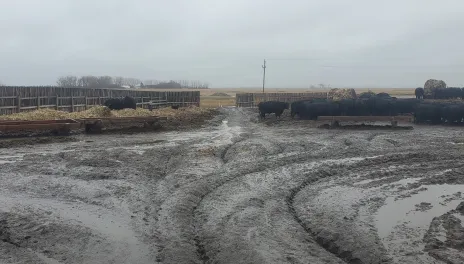Snow and rain equal mud
Snow melt, rain, and cattle create a recipe for muddy feedlots. While uncomfortable for ranchers, mud is stressful to livestock. Just a few inches of mud require extra effort for cattle to walk and may lead to a loss of production or weight gain.
As mud depth increases to 4 to 8 inches, feed intake can decrease up to 15%. When mud is up to 24 inches deep, feed increase can decrease by 30%. The effects of mud on performance are especially profound when bedding is unavailable.
Providing more space for cattle in pens will reduce the depth of mud that cattle tromp up. When extra space is not available, bedding can be used to reduce the effects of mud. Two pounds of bedding per animal is needed to overcome 2 inches of mud.
Research at the NDSU Carrington Research Extension Center found benefits by bedding at 2 to 2.5 pounds of straw per head day. Bedding reduced cost of gain and increased marbling score in fed cattle. Mature cows and bulls may need 5 pounds of bedding per day to find comfort.
When dealing with mud, an alternative to bedding is concrete. Heavy use concrete pads, barns with indoor concrete floors, or completely concreted pens are effective but expensive options. Cleaning concrete pens regularly is recommended but this can be difficult during winter when bedding packs are frozen.
Moving cattle to a sod pasture will provide relief from muddy feed yards. However, water saturated sod pasture can quickly turn to mud with cattle hoof action.
Mud will likely be an issue for farms and ranches when spring arrives. Taking precautions now should help reduce performance loss and improve cattle health.
For a more thorough discussion on this topic, read https://www.ag.ndsu.edu/news/newsreleases/2024/march/beware-of-mud-season .
Karl Hoppe, Ph. D.
Karl.Hoppe@ndsu.edu
Extension Livestock Systems Specialist
